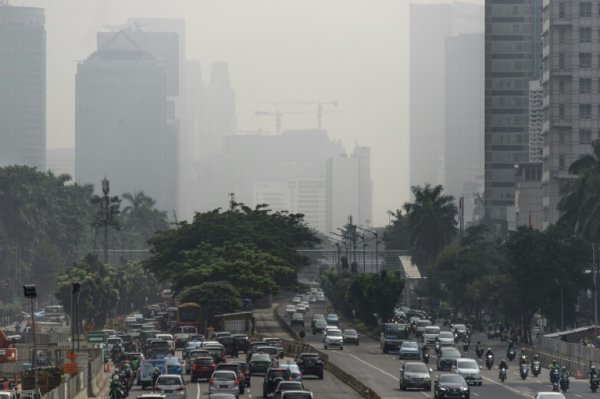
Land decay caused by factors including pollution — as seen here in Jakarta, Indonesia — and city expansion is undermining the well-being of some 3.2 billion people, scientists say © BAY ISMOYO – AFP/File
Land degradation will unleash a mass migration of at least 50 million people by 2050 — as many as 700 million unless humans stop depleting the life-giving resource, more than 100 scientists warned Monday.
Already, land decay caused by unsustainable farming, mining, pollution, and city expansion is undermining the well-being of some 3.2 billion people — 40 percent of the global population, they said in the first comprehensive assessment of land health.
Land depletion threatens food security for all Earth’s citizens, and access to clean water and breathable air regulated by the soil and the plants that grow on it.
The condition of land is “critical,” alerted the Intergovernmental Science-Policy Platform on Biodiversity and Ecosystem Services (IPBES).
“We’ve converted large amounts of our forests, we’ve converted large amounts of our grasslands, we’ve lost 87 percent of our wetlands… we’ve really changed our land surface in the last several hundred years,” IPBES chairman Robert Watson said.
“Land degradation, loss of productivity of those soils and those vegetations will force people to move. It will be no longer viable to live on those lands,” he told AFP.
The lowest number of 50 million migrants is a best case scenario.
It assumes “we’ve really tried hard to have sustainable agricultural practices, sustainable forestry, we’ve tried to minimize climate change,” Watson explained.
The high projection is based on a “business-as-usual” approach in which rampant global warming wreaks havoc with the land — fueling desertification and drought.
Last frontier
By 2050, said the analysis, land degradation and climate change will reduce crop yields by 10 percent globally — up to half in some regions.
The report covers the entirety of Earth’s land, as well as the lakes and rivers it supports.
It estimated that land degradation cost the equivalent of 10 percent of global economic output in 2010.
“Every five percent loss of gross domestic product… is associated with a 12 percent increase in the likelihood of violent conflict,” warned the report.
Already, in dryland areas, years of extremely low rainfall see an estimated 45 percent rise in violent conflict.
The main drivers of land degradation, said the assessment, were “high-consumption lifestyles” in rich countries, and rising demand for products in developing ones, fuelled by income and population growth.
Less than a quarter of land has managed to escape “substantial impacts” of human activity — primarily because it is found in inhospitable parts of the world — too cold, too high, too dry, or too wet for humans to live in.
Even this small repository is projected to shrink to less than 10 percent in just 30 years’ time.
“People are pushing into those frontiers,” Bob Scholes of the University of the Witwatersrand in South Africa, a co-author of the paper, told AFP.
Global warming permits people to move into the icy, subarctic Boreal region, for example, while technology now allows us to pump water from deep aquifers in the extreme desert.
Crop and grazing lands now cover more than a third of the Earth’s land surface.
This means not only a loss of soil, but also populations of wild plants and animals, and forests that suck up planet-warming carbon dioxide and produce oxygen.
“Biodiversity loss is projected to reach 38-46 percent by 2050,” said the report, warning that Earth is in the beginnings of a sixth mass extinction — the first since the demise of the dinosaurs 65 million years ago.
The IPBES assessment took global experts three years to compile, analyzing all the available scientific data.
Climate change
The report identified land degradation as a major contributor to climate change, and vice versa.
Deforestation alone contributes about 10 percent of human-induced greenhouse gas emissions.
And by releasing carbon once locked in the soil, land decay was responsible for global emissions of up to 4.4 billion tonnes of carbon dioxide per year between 2000 and 2009.
“Without urgent action, further losses of 36 gigatons of carbon from soils — especially from sub-Saharan Africa — is projected by 2050,” the scientists warned.
This is equal to about 20 years of global transport emissions.
In 30 years from now, an estimated four billion people — about 40 percent of the projected population — will live in arid and semi-arid areas with low agriculture productivity, said the report.
Today, the number is just over three billion.
The assessment “is a wakeup call for us all,” said Monique Barbut, executive secretary of the UN Convention to Combat Desertification, which requested the report.
“It shows the alarming scale of transformation that humankind has imposed on the land.”
The report, which cost about $1 million (810,000 euros) to prepare, is meant to inform government policy-making.
It was approved by government envoys at a week-long meeting of the 129-member IPBES in Medellin. MKH
RELATED STORIES:
UN schemes to save forests ‘can trample on tribal rights’
LOOK: Earth Hour around the world